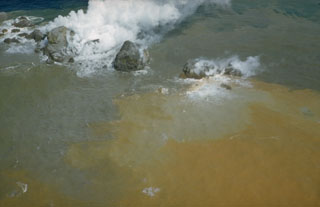Report on Myojinsho (Japan) — December 1980
Scientific Event Alert Network Bulletin, vol. 5, no. 12 (December 1980)
Managing Editor: David Squires.
Myojinsho (Japan) Discolored water seen on 23 December
Please cite this report as:
Global Volcanism Program, 1980. Report on Myojinsho (Japan) (Squires, D., ed.). Scientific Event Alert Network Bulletin, 5:12. Smithsonian Institution. https://doi.org/10.5479/si.GVP.SEAN198012-284070
Myojinsho
Japan
31.888°N, 139.918°E; summit elev. 11 m
All times are local (unless otherwise noted)
The Japanese Maritime Safety Agency (JMSA) continues frequent aerial monitoring of several known submarine volcanoes. Renewed activity at Myojin-sho was first observed from a fishing boat on 15 November. [Overflights on 14 November and 18 December did not cover Myojin-sho, but that on 23 December observed discolored water at the site.]
Further Reference. Smoot, N.C., The growth rate of submarine volcanoes on the South Honshu and East Mariana Ridges: JGVR. [Bathymetric data on this and following seamounts throughout the Mariana arc.]
Geological Summary. Beyonesu Rocks are part of the barely exposed rim of the largely submarine Myojinsho caldera. Formation of the 8-9 km wide caldera was followed by construction of a large (2.6 km3) lava dome and/or lava flow complex on the caldera floor, originally located at a depth of 1,000-1,100 m. Most eruptions recorded since the late-19th century have occurred from the dacitic post-caldera Myojinsho lava dome on the NE caldera rim. Deposits from submarine pyroclastic flows associated with growth of the dome cover it and extend both into the NE part of the caldera and down its outer slopes. An explosive submarine eruption from Myojinsho in 1952 destroyed a Japanese research vessel, killing all 31 on board. Submarine eruptions have also been observed from other points on the caldera rim and outside of the caldera. The Beyonesu Rocks were named after the French warship the Bayonnaise, which was surveying volcanic islands south of Tokyo Bay in 1850.
Information Contacts: JMA, Tokyo.

